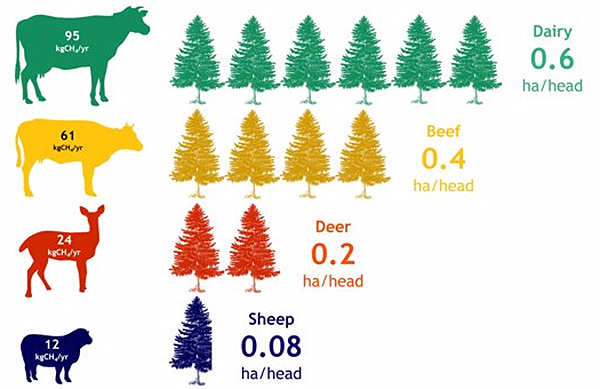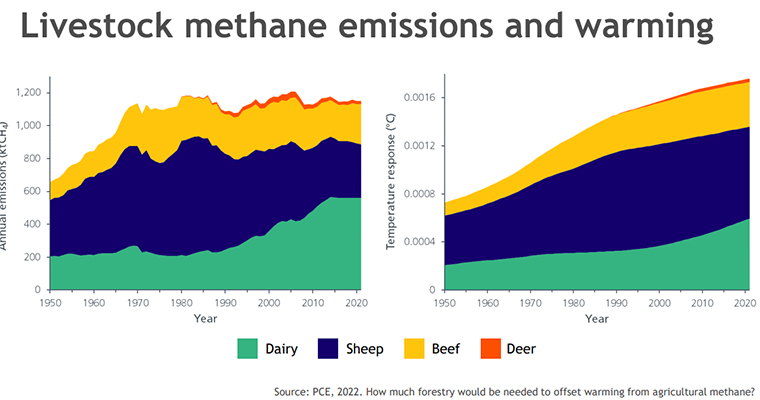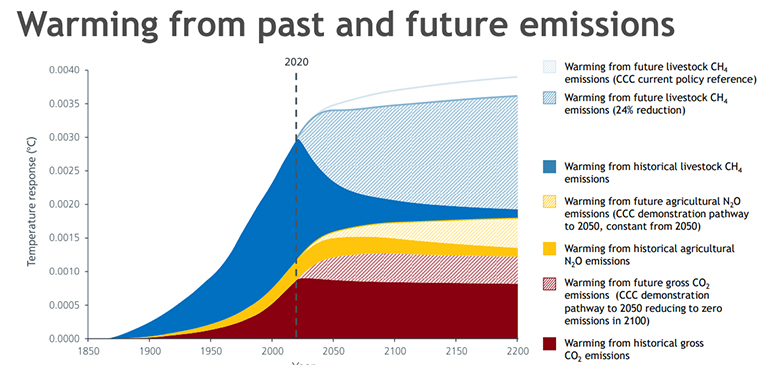
The New Zealand Agricultural Climate Change Conference 2023 (NZAGRC) finished a few days ago. It aimed to showcase the latest research and policy developments and implementation actions being undertaken to reduce agricultural greenhouse gases in Aotearoa New Zealand.
Given the recent flooding events around the country in the last 12 months or so the audience will have been more receptive than ever. To date the proceedings are still to be published with the exception of the main gist of the speech presented by the Parliamentary Commissioner (PCE) for the Environment Rt Hon Simon Upton. In my view he has always presented a rational approach and hasn’t avoided the hard questions even if he spells them out a bit more diplomatically than some.
He has avoided bringing the latest flooding into his speech, however he has here and in a previous publication last October brought the issue of utilising trees as offsets for methane (CH4) into the discussion. He is on record as believing that trees should not be seen as a means to opt out of GHG emissions. However he does believe there is a case for them to be utilised in the case of livestock and specifically in offsetting CH4 emissions. However, I interpret this as only being a stop gap solution until other technologies that actually reduce methane emissions come into production and also by targeting less productive land avoid the “wholesale land use change driven by fossil fuel emitters who have no long term stake in the land”.
However, he believes that tree planting can only ever be part of the solution due to the “unrealistically large area of forest (required)”. The table below shows just how much per animal class requires as an offset for its emissions.

Sources: PCE Publications 2022.
Why the focus on CH4? He quotes data that shows that CH4 is responsible for up to 55% of New Zealand’s contribution to warming (as opposed the GWP which measures different parameters) and believes the focus needs to be on methane due to the ability to not only stop emissions but due to its shorter active life in the atmosphere actually reduce CO2e concentrations and the effects there after. As opposed to carbon dioxide largely from fossil fuels which are there for hundreds of years. And, as we have the means (or hopefully with current research).
In the graph below he outlines why CH4 needs to be reduced. The left-hand side graph illustrates methane emissions and shows how they have been relatively constant for the last 30 years however their contribution to GHG warming are still increasing.

The increases are due to “inertia in the heat transfer between different parts of the Earths system” and other climate feed back loops.
Not only does the PCE believe Government need to review its policy on farm trees for methane but also it needs to narrow down (not necessarily decrease) its 2050 target for methane emissions which are currently between 24%-47%. (if we use the Fonterra payout analogy that would put the likely target at around 35%). He believes it needs to be far more focused to allow better planning. His graph below shows the combined impact of all gas emissions, currently and into the future.

Reading the PCE speech has brought the question around plantations back into focus again although I doubt that was his intention.
Having just watched “Sunday” on the impact of the flooding and John Campbells doco “Slash” the policy around trees gains far more significance. Government and Council policies could dictate what land had to go into trees post-Bola so their response post the 2 month review on forestry on the East Coast will be interesting.
Ultimately for the East Coast the final say does reside with them. Overseas owners may believe they have the rights to do what they can still legally can (or illegally as the case may be) but if Ngati Porou want to they could make logging an impossible task within their boundaries and judging by some of the passion shown in the doco that may be an option.
So, while the PCE speech didn’t discuss the East Coast I can’t help feeling that his attitude to carbon plantations in some placements may have changed. On the evidence of what has just happened, mine has.
In 10 years time when the current layers of slash has disappeared and the scars have healed over then perhaps future policies on logging could be re-examined but at the moment if I was a ‘Coasty” I would want the loggers out and New Zealand doing what it can to reduce future impacts of climate change.
I hope in the mass of questioning that many parts of the country are now carrying out with a view to climate adaptation, they are not forgotten.
22 Comments
any mention at the conference of...?
If we combine pastures used for grazing with land used to grow crops for animal feed, livestock accounts for 77% of global farming land. While livestock takes up most of the world's agricultural land it only produces 18% of the world's calories and 37% of total protein.
Animal products also produce nearly 50% of the world's dietary calcium and a large chunk of micronutrients like iron, zinc, choline and vitamins, in a more bioavailable form than from plants. And the lower quality of plant sourced protein compared to animal sourced means that you need to eat more to have the same effect.
Calories are no problem, we could feed everyone on grains, sugar and seed oils using far less land but that's the road to obesity, diabetes and malnutrition.
Exactly - just look at the soil loss - LINZ just put up some imagery of the rivers around Napier - see some of the hills up valley and see where all the soil in the valleys came from - Should we permit this to continue? Should we prosecute these lands for allowing this to happen when it is known it will?
Not to worry there will be no new forestry much North of Napier now - it is un investible - farmers have it all to themselves to fix and they can trade the land between themselves as they have desired. Lets do B and L idea and get rid of Permanent forest as well - good sheep and beef country.
You forget or don't recognise that a chunk of soil erosion is a natural process irrespective of land use. Particularly on the soft, young rock types common along the North Island east coast.
Also all the highly productive alluvial flood plains (Poverty Bay, Wairoa, Esk Valley, Heretaunga, Ruataniwha, Wairarapa, etc) are the direct result of those natural erosion processes.
Trees are useful to reduce shallow slip erosion, not the deep seated slumping. No tree root system can penetrate that deep into the soil profile.
The solution is (1) fining pine forest owners out of business to clean up the damage they allegedly caused, (2) remove the Pines and (3) plant commercial production forests of native trees. The Minister of Forestry (2023) Stuart Nash stated on 5 March 2023, during the TV1 (John Campbell) documentary, that he (Nash) knew the problem of forestry pine waste/slash was because Forestry owners were not clearing the pine waste/slash off their properties. Knowing is negligence? So why hasn't Minister Stuart Nash and the Pine Forest Owners been charged by the NZ Police for alleged criminal wilful damage and possibly criminal manslaughter by now?
The government ought to set up a tribunal where people who have suffered loss due to forestry slash coming through their property can seek redress in a cost effective way. Currently you are looking at 50-100k in costs to take them to court, with an uncertain outcome.
That would go a long way towards encouraging forestry operations to be done in a way to prevent slash from ending up in the waterways.
Try crowd funding or ask for help from the already established crowd funders for the disaster. Ask everyone for help. PS: There is NO stopping pine slash. Nash's idea doesn't work; as all it does is collect thousands of tonne mountains of pine waste/slash, at the bottom stream valleys, that over-weight hillslopes and causes the ground beneath to slip into the streams; and the pine slash/waste ends up in the river... Nash and the Forestry front people purportedly are Trump MAGA types, ostensibly always ready with a fake conspiracy theory to divert the truth away from them.
Kauri plants can be purchased locally in Kawkes Bay i.e. Greenleaf Nurseries in Hastings. If you want to see a Kauri, go to your local public gardens anywhere on the East Coast and look at the little signs at the bottom of the trees until you find one that reads Kauri Tree.
Every time Nash and Hipkins open their mouths, it appears there is no one coming to fully compensate the communities and landowners on the East Coast allegedly destroyed by forestry pine slash/waste. I have just come back from a meeting with our QC, who tells us they would need to amass a team of QC's to sue the Forestry operators for the 13.5 billion dollars in alleged damages, and undertake Civil action against the Operators, Nash, Hipkins and MBIE executive in the High Court for alleged criminal wilful damage and alleged criminal manslaughter. All the damage effected land owners and communities need to do is crowd fund 1.5 million, and we will be into it.
Who paid for the forestry slash damage in the 1948 Poverty Bay floods?
https://teara.govt.nz/en/video/33279/1948-flood
*This comment was funded by MAGA, Big Oil and the Lizard People.
With more climate change coming, we have to start to think about building more ResilientHomes.
Homes that can withstand some flooding, and can be quickly and easily cleaned out and reoccupied in a week or so. Timber and gib on a concrete base is not the way forward for houses on flood plains, or at risk of requiring a managed retreat.
Houseboats. Tethered upstream, flexible or part-able services.
There's a marina building in Maryborough Queensland. The tide mark - repeatedly - is half-way up the upstairs windows (2 storey building). They can evacuate all stock, disconnect the pontoons, float the lot up the street, back down the street and re-connect. 24 hours later, the wiring is given the OK and they're back open for business.




We welcome your comments below. If you are not already registered, please register to comment.
Remember we welcome robust, respectful and insightful debate. We don't welcome abusive or defamatory comments and will de-register those repeatedly making such comments. Our current comment policy is here.